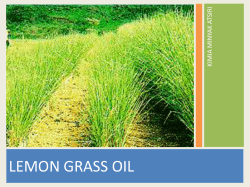
SIRCHIE®
TI03-27ENG-REV3 SIRCHIE Products • Vehicles • Training Copyright© 2011 by SIRCHIE All Rights Reserved. ® TECHNICAL INFORMATION Explosives Residue Test Kit Catalog No. ERTT10 INTRODUCTION Based upon an extremely sensitive test for nitrates, this kit is suitable for use in the laboratory or in the field to verify the presence of explosives in suspected debris. The test components have been pre-measured and packaged to make testing in the field easy and accurate when examining an explosive material as small as a grain of salt (0.06 gram). This test alone is not conclusive for the presence of explosives since other nitrates can also give positive results. Results from this test should be further verified with confirmatory testing in a laboratory. PRECAUTIONS • Before using this kit, consult the appropriate Material Safety Data Sheets (MSDS) found on our website at www.sirchie.com/ support. 100 HUNTER PLACE, YOUNGSVILLE, NC 27596 USA Ph: (919) 554-2244, (800) 356-7311 • Fax: (919) 554-2266, (800) 899-8181 • Web: www.sirchie.com • Email: sirchieinfo@sirchie.com 1 of 4 TI03-27ENG-REV3 • Wash hands thoroughly prior to using this kit. • Warning! The ER1 Extract Reagent in this kit contains chloroform. In case of exposure, consult the MSDS. • Wear protective clothing, safety glasses, and nitrile gloves when handling the chemicals in this kit. • Warning! The 290P2 reagent contains sulfuric acid and is highly corrosive. It is recommended that rubber or vinyl gloves be worn when opening ampoules, when applying the reagent, and when disposing of all materials that come in contact with the reagent. TEST PROCEDURE The following directions are applicable to both field and laboratory use when it is ascertained that soil, a fragment of material, portion of a solid, or dust particles at the scene of a fire or explosion might contain an explosive residue. 1. Using the tweezers provided in the kit, transfer a grain of suspected material to an extract retention vial as shown in Fig. 1. (If the sample is a powder, use the small stainless steel spatula rather than the tweezers.) 2. Remove an extract reagent ampoule labeled ER1. A scored band will be found at the neck of each ampoule that indicates the break-open point. Open by holding the base of the ampoule in one hand, use your other hand to snap the end of the ampoule off at the scored line (Fig. 2). If the ampoule does not break easily, carefully place the end in a towel or paper and crush the tip with your hand or a hard object. 3. With a disposable pipette, transfer enough of the ER1 extract reagent to the extract retention vial to cover the suspected debris (Fig. 3). FIGURE 1 FIGURE 2 2 of 4 FIGURE 3 TI03-27ENG-REV3 FIGURE 4 FIGURE 5 FIGURE 6 FIGURE 7 4. Close the sample vial tightly and shake for one (1) minute. 5. Place one of the capillary tubes into the bulb tipped holder (Fig. 4). Squeeze the bulb slightly, and place the capillary into the retention vile. Release the bulb to allow the liquid to enter the capillary tube (Fig. 5). 6. Holding the capillary in a vertical position, place the bottom tip onto the thin layer chromatogram sheet. Upon contact with the sheet the liquid will drain out (if the liquid does not come directly out, squeeze the bulb gently until the capillary action begins). Repeat steps 5 and 6 several times to concentrate the liquid at the spot. Allow time for the liquid to evaporate after each application (Fig. 6). 7. Remove the ampoule labeled 290P2, and open it as previously described. 8. Using a new disposable pipette, drop some of the 290P2 color-developing reagent onto the chromatogram sheet in the area where the spot is located (Fig. 7). 9.A blue to almost black color is a positive reaction for nitrates. If a positive reaction is obtained, place a larger sample in a solid sample collection vial and label it for transfer to the laboratory for more comprehensive tests. 3 of 4 TI03-27ENG-REV3 TEST FOLLOW-UP 1. Using a small piece of swabbing cotton wetted with some of the leftover extract reagent (ER1), clean off the forceps or spatula. They are now ready for the next use. 2. The kit was designed in the disposable concept because this test is extremely sensitive. The disposable pipettes, capillary pipette, ERI REPLACEMENT SUPPLIES: extract reagent ampoule, and ER1���������Extract Reagent, Sealed Glass Ampoule, 1ml 290P2 color-developing reagent 290P2�����Color-Developing ampoule should be disposed Reagent, Sealed Glass of to avoid contamination of a Ampoule, 2ml sample. 3. The ER1 extract reagent is nonflammable. KCP174��� Thin Layer Glass Chromatogram Sheets, 2 per pkg. 288DP����� 3ml Disposable Pipette w/capillary and bulb KCP191��� Box of 100 capillaries and holder ERTT10 CONTENTS: 20-288DP Pipettes, Disposable, w/ Capillary and 3ml Bulb 10-290P2 P2 Color Developing Reagent, Ampoules, 2ml 1-ACN2 Acid Neutralizer, 2 oz. (59ml) 3-EIL011 Evidence Identification Labels, “Crime Evidence” 10-ER1 Extract Reagent 1, Ampoules, 1ml 1-KCP139 Tweezers, Plastic, 4.75" (12.1cm) 1-KCP140 Spatula, Stainless, Micro 3-KCP173 Vial, Glass, 1/2 oz. w/ Closure 10-KCP174 TLC Plates, Silica Gel 60A, 250µm Layer, 5cm x 10cm 1-KCP191 Box of 100 capillaries and holder KCP171��� Extract Retention Vials, ½ fl. dram (1.85ml) 15-KCP217 Cotton Balls SF0075���Pair Vinyl Gloves 10-KCP171 Vials, Glass, w/Closure, 1/2 dram KCP173��� Collection Vial, 4 fl. dram (14.8ml) glass w/ EIL011 pressure sensitive ID labels KCP139��� Tweezers, Plastic KCP140��� Stainless Steel Spatula KCP217��� Cotton Balls 4 of 4 1-SF00771 Latex Powdered Glove Pair, Ambidextrous, .005" thick, Lg. 1-ERTT101 Carrying Case, Molded Copolymer, w/Latch; Dimensions: 16.25" x 7.25" x 8.625" (41.6cm x 21.9cm x 17.8cm); Weight: 4 lbs. (1.8kg)
© Copyright 2025











